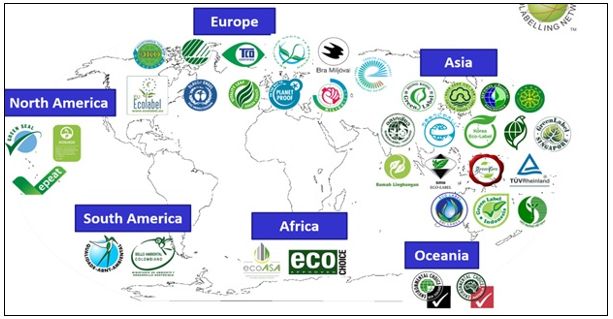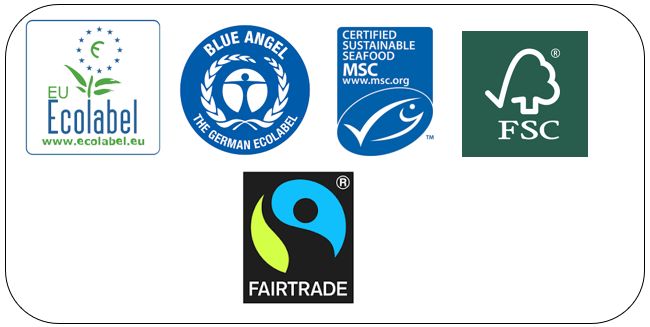INTRODUCTION
In an era marked by unprecedented environmental challenges, the imperative for sustainable and responsible consumption has become increasingly apparent. The global community faces the daunting task of mitigating the adverse impacts of human activities on the planet. In this context, eco labels emerge as beacons of hope, guiding both consumers and businesses towards a more environmentally conscious future.
The past few decades have witnessed a surge in awareness regarding environmental degradation and climate change. From rising temperatures to dwindling biodiversity, the signs of ecological distress are glaring. As consumers become more attuned to the consequences of their choices, there is a growing demand for products and services that align with principles of sustainability. In response to this, the Advertising Standards Council of India (ASCI) has introduced guidelines titled "Guidelines for Advertisements Making Environmental/Green Claims," slated to take effect on February 15, 2024. These guidelines not only define greenwashing but also offer directives and warnings for advertisers, aiming to ensure the credibility, verifiability, and transparency of environmental claims. The piece also underscores the attention given to greenwashing by the Securities and Exchange Board of India (SEBI) and the existing measures, including the Consumer Protection Act, 2019, and guidelines from the Central Consumer Protection Authority (CCPA). In Addition to the guidelines the eco label mechanism can help to bridge the gap between environmental awareness and responsible consumption.
At its core, an eco-label is a symbol or certification that signifies a product or service adheres to specific environmental standards1. These labels serve as a tangible link between conscientious consumerism and the global effort to address ecological concerns. They provide a means for consumers to make informed choices, rewarding businesses that prioritize environmental sustainability.
Eco labels play a multifaceted role in the global pursuit of sustainability. They serve as powerful tools for communication, conveying complex environmental information in a concise and accessible manner. Moreover, these labels act as catalysts for positive change within industries, incentivizing companies to adopt greener practices to remain competitive in a discerning market.
One of the driving forces behind the prominence of eco labels is the shift in consumer behaviour. Modern consumers are not merely purchasers; they are conscientious decision-makers seeking products that align with their values. Eco labels empower consumers to vote with their wallets, creating a ripple effect that compels businesses to integrate sustainability into their core practices.
This article aims to provide a comprehensive exploration of the ASCI Guidelines pertaining to advertisements of Environmental or Green Claims that are set to take effect on 15th February, 2024, along with eco labels – their underlying principles, diverse types, and their significance in both a global and regional context.
ASCI GUIDELINES
The rising consumer demand for products and services that either minimize environmental harm or contribute positively to the environment has become more pronounced. With a surge in the availability of products, services, and businesses tend to provide greenwashed claims. To combat greenwashing in across various industries, The Advertising Standards Council of India (ASCI), has released guidelines which would help curb deceptive pro-environment assertions. Titled "Guidelines for Advertisements Making Environmental/Green Claims", these guidelines have been available for public input since November 16, 2023, and received approval in the recent Board of Governors meeting. As defined by ASCI, Greenwashing refers to "false, deceptive, misleading environmental claims about products, services, processes, brands or operations as a whole, or claims that omit or hide information, to give the impression they are less harmful or more beneficial to the environment than they really are"2. Scheduled to take effect on February 15, 2024, the objective of these guidelines is to guarantee the credibility, verifiability, and transparency of environmental claims put forth by advertisers, as stated in a press release by the advertising regulator.
The Guideline defines Environmental Claim or Green Claim as – statements that suggest or create the impression that a product or service which:
- Positively impacts or is neutral to the environment.
- Causes less environmental harm than a previous version of the same product or service.
- Inflicts less environmental damage compared to competing goods or services.
- Possesses specific environmental benefits.
The Guideline states that greenwashing violates Chapter I of the ASCI Code on misleading advertisements. Additionally, the Guideline lays down certain dos and don'ts for advertisers which are as follows:
|
DO's |
Don'ts |
|
Do provide high-level substantiation for absolute claims such as "environment-friendly", "eco-friendly", "sustainable", and "planet-friendly". |
Don't mislead consumers by highlighting the absence of environmentally damaging ingredients that are not typically found in competing products. |
|
Base environmental claims on the full life cycle of the advertised product or service |
Don't make claims about the environmental benefits resulting from a legal obligation unless competing products are subject to the same requirements. |
|
Specify the scope of environmental claims, indicating whether they refer to the product, packaging, service, or a specific portion thereof. |
Don't claim carbon offsets represent emission reductions if they will not occur for two years or longer; disclose this information clearly and prominently. |
|
Use certifications and seals of approval from nationally / Internationally recognized certifying authorities, clearly stating the attributes evaluated and the basis of certification. |
Don't make claims about product compostability, biodegradability, recyclability, non-toxicity, or being free-of without specifying the aspects to which these claims are attributed. |
|
Ensure that visual elements in advertisements accurately represent the environmental impact of the product or service, avoiding false impressions |
Don't make environmental claims without competent and reliable scientific evidence demonstrating that the product or qualified component will break down within a reasonably short period after customary disposal. |
|
Refrain from making aspirational claims about future environmental objectives unless backed by clear and actionable plans. |
Don't make claims about products being free of elements that can lead to environmental hazards without supporting scientific evidence |
Apart from the proposed guideline, Greenwashing gained significant attention in India following the release of a circular by SEBI addressing green-debt securities3. SEBI defined greenwashing as the act of "making false, misleading, unsubstantiated, or otherwise incomplete claims about the sustainability of a product, service, or business operation". While strict provisions directly targeting greenwashing practices are still lacking, there are measures to address this issue through indirect channels, as elaborated further. The Consumer Protection Act, 2019 (CPA), in Section 2(9)(ii), grants consumers the right to be informed about the quality, quantity, potency, purity, standard, and price of goods, products, or services. This provision aims to safeguard consumers from Unfair Trade Practices, as defined under Section 2(47) of the Act.
Moreover, in the exercise of its authority under section 18 of the Consumer Protection Act (CPA), the Central Consumer Protection Authority (CCPA) issued the "Guidelines for Misleading Advertisements and Endorsements for Misleading Advertisements"4 in 2022. These guidelines prohibit all forms of misleading and false advertisements, irrespective of their form, format, or medium. This prohibition applies to manufacturers, service providers, or traders whose goods, products, or services are the subject of such advertisements, as well as advertising agencies or endorsers engaged for promoting such goods, products, or services. The guidelines primarily establish conditions for creating non-misleading and valid advertisements, delineate the responsibilities of manufacturers, service providers, advertisers, and agencies, and prescribe conditions for disclaimers in advertisements5. Advertisements that make false claims about environmental benefits or sustainability features may be deemed misleading according to these guidelines.
Subsequently, in an effort to tackle Greenwashing, the CCPA concluded its third meeting on 11th January, 2024, which focused on drafting guidelines for the "Prevention of Greenwashing by Companies"6 to safeguard consumer interests. According to the guidelines, companies must provide accurate claims supported by verifiable evidence and disclose relevant material information related to these claims. The guidelines also aims to offer clarity for stakeholders, and any breaches of the provisions outlined in the Consumer Protection Act, 2019, which will be subject to the existing regulations within the same Act. In addition, besides the Consumer Protection Act (CPA), the Companies Act, 2013, indirectly addresses Greenwashing practices through Section 34. This section imposes criminal liability under Section 447 on individuals who authorize the inclusion of false or misleading statements in the offer document for fundraising.
Subsequent to the above, a question arises as to the penalty to be imposed on Companies which do not adhere to the ASCI Guidelines. Since The Consumer Protection Act, 2019 gives the consumer the right to seek redress against misleading or false advertisements, the punishments for false or misleading environmental or green claims should be as per the Act. In addition to the above provisions, Ecolabels would also act as good indicators to target greenwashing practices by companies. However, it is imperative to understand what ecolabels are and how they would assist in eliminating greenwashing along with the ASCI guidelines.
ECO LABELS AND ITS PRINCIPLES
What are Eco Labels?
Eco labels, also known as environmental labels or ecolabels, are symbols or logos placed on products to communicate to consumers that the items have met specific environmental or sustainability criteria7. These labels serve as a tool for both businesses and consumers to make informed choices that align with environmental values.

Eco Labelling – Global Experiences8
The primary purpose of eco labels is to address the growing concern about the environmental impact of products and services. As consumers become more environmentally conscious, they seek ways to make sustainable choices in their purchasing behaviour. Eco labels play a crucial role in facilitating this process by providing clear and standardized information about the environmental attributes of a product.
The concept of eco labelling gained prominence in response to the escalating environmental challenges faced globally. The idea was to create a system that could guide consumers toward environmentally friendly products and encourage businesses to adopt sustainable practices. The origins of eco labels can be traced back to the late 20th century when environmental awareness started gaining momentum.
One of the pioneering eco labels was the Blue Angel, introduced in Germany in 1978. This label, awarded to environmentally friendly products, laid the foundation for similar initiatives worldwide. Over the years, various organizations and governments have developed their eco-labelling programs, contributing to the global evolution of this concept.
Principles of Eco Label9
These principles form an integral part of ISO 14020, serving as a prerequisite for all other standards within the series.
- Environmental labels and declarations must be precise, verifiable, pertinent, and devoid of any misleading information.
- Procedures and criteria for environmental labels and declarations should not be formulated, adopted, or implemented to create unnecessary hindrances to international trade.
- Scientific methodology supporting environmental labels and declarations must be sufficiently thorough and comprehensive, ensuring accurate and reproducible results.
- Information about the process, methodology, and criteria supporting environmental labels and declarations must be accessible and provided upon request to all concerned parties.
- The development of environmental labels and declarations should encompass all relevant aspects of the product's life cycle.
- Environmental labels and declarations must not impede innovation that either sustains or has the potential to enhance environmental performance.
- Administrative requirements and information requests related to environmental labels and declarations should be limited to those necessary for confirming adherence to applicable criteria and standards.
- The process of formulating environmental labels and declarations should involve an open and participatory consultation with interested parties. Efforts should be made to achieve consensus throughout the process.
- Information on the environmental attributes of products and services relevant to an environmental label or declaration should be accessible to purchasers and potential purchasers from the entity issuing the environmental label or declaration.
TYPES OF ECO LABELS
International Organization for Standardization or ISO has set various standards covering different types10 of Environmental labels and declarations:
- ISO 14024 -Third Party - (Type I environmental labelling)
A 'Type I' label is a third-party evaluation of a product based on a set of criteria and concerns related to the products or material's environmental effect throughout its life cycle. Type I environmental labelling' is defined by ISO as: "a voluntary, multiple-criteria based, third party programme that awards a license which authorises the use of environmental labels on products indicating overall environmental preferability of a product within a particular product category based on life cycle considerations."
This type of ecolabel is:
- designed to be consumer-friendly and informative
- based on the fulfilment of a set of criteria
- awarded by a certified third-party program
- often government supported
- criteria and categories are defined by independent experts, e.g. academic researchers, but also include input from interest groups and technical experts
- evaluation and selection requirements are available to the public
- certification is granted for a specific time period after which the product/service needs to be recertified
Type I is considered the so-called gold standard for consumer education because there is an independent certifying body. Common examples include the EU Ecolabel, the Blauer Engel, Marine Stewardships Certification, Forest Stewardship Council, and Fair Trade.

Examples of Type I Ecolabels
- ISO 14021- Self-declared environmental claims (Type II environmental labelling)
Ecolabelling of type II is based on self-declaration of environmental predication by the producer, importer, distributor, retailer or anybody who benefits from the predication while the declaration is not certified by an impartial third party. This type of ecolabel is:
- self-declared
- focuses on a particular quality of a product, e.g. compostable
- not independently certified
- should be verifiable (but is not always)
- can raise questions about the validity of certification when unverifiable
ISO 14021 defines and clarifies a number of widely used words in claims, whether on the product or elsewhere, such as product literature, advertising, or reports. It also explains the procedures for evaluating each word to verify that they are legitimate and scientifically sound.
Additionally, ISO 14021 has a detailed set of basic criteria for the usage of undefined words. Other label-related information and recommendations, such as the usage, location, and size of symbols and images, are also described.
- ISO 14025- Environmental Product declarations - (Type III environmental declarations)
Type III environmental declarations present quantified environmental information on the life cycle of a product to enable comparisons between products fulfilling the same function. It defines the concepts and methods for producing declaration data as well as the standards for declaration programs, including the need for data to be independently validated. Such declarations:
- are based on independently verified life cycle assessment (LCA) data, life cycle inventory analysis (LCI) data or information modules in accordance with the ISO 14040 series of standards and, where relevant, additional environmental information,
- are developed using predetermined parameters, and
- are subject to the administration of a programme operator, such as a company or a group of companies, industrial sector or trade association, public authorities or agencies, or an independent scientific body or other organization.
Type III environmental declarations as described in ISO 14025 are primarily intended for use in business-to-business communication, but their use in business-to-consumer communication is not precluded.
INDIAN PERSPECTIVE ON ECO LABELS
In India, the Ministry of Environment, Forests, and Climate Change (MoEFCC) has taken significant steps to promote environmentally friendly products through the establishment of eco-labelling initiatives. The country's first program, the "Eco mark", launched in 199111 under the Central Pollution Control Board (CPCB), serves as a notable example of India's commitment to sustainable practices.
The Eco mark certification program adopts a comprehensive cradle-to-grave methodology, considering the entire life cycle of a product, from raw material extraction to disposal.12 The program, governed by the CPCB, encourages the resolution of environmental protection issues and the implementation of policies to safeguard the environment. It actively involves the government, industry, and consumers, aiming to promote sustainable practices and improve overall environmental quality for long-term sustainability.

Ecomark Scheme Logo
The Ecomark program operates through a structured governance system, involving key committees:
- Steering Committee13: Formed within the MoEFCC, this committee defines product categories, promotional methods, and strategies for program development and improvement.
- Technical Committee14: Under the CPCB, this committee is responsible for selecting specific products and criteria. It ensures adherence to quality and environmental standards set by the Bureau of Indian Standards (BIS).
BIS (Bureau of Indian Standards)15: Responsible for implementing the scheme, BIS conducts testing and certification processes. The certification is granted by BIS, and the label may be revoked if products fail to meet environmental requirements.
Manufacturers seeking Eco mark certification can apply under various product categories, demonstrating adherence to established environmental standards. The certification process, conducted by BIS, includes testing, and items are labelled based on the results. Certification is typically valid for one year, requiring renewal through a license fee payment to maintain active status.
The Eco mark program utilizes an earthen pot as its symbol, signifying the use of soil as a renewable resource, minimal hazardous waste production, and lower energy consumption. This symbol effectively communicates its environmental message, resonating with consumers.
The CPCB formulated a criteria for environmentally favourable products. To bestow an environmental label, products must comply with quality and environmental standards outlined by the BIS, ensuring a balance between environmental responsibility and product quality and safety.
The CPCB has identified various product categories eligible for the Eco mark, including aerosol propellants, batteries, cosmetics, electrical/electronic goods, and more. Thirteen out of sixteen categories have incorporated Ecomark requirements into their BIS standards, emphasizing the program's expansive reach and potential impact.
EU GREENWASHING DIRECTIVE
The EU Greenwashing Directive16 functions as a legislative framework crafted to counteract the phenomenon of greenwashing within the European Union. Greenwashing involves intentionally distorting or misrepresenting the true environmental impact associated with a product, service, or business by creating a misleading or exaggerated perception of environmental responsibility. The implementation of this law was prompted by a growing scepticism regarding the credibility of environmental claims made by corporations. Its objective is to establish processes and guidelines that foster accuracy and transparency in environmental communication.
The directive emphasizes the significance of cultivating a sustainable economy by supporting authentic environmentally conscious efforts and condemning deceptive practices that undermine their legitimacy. A key aspect of the directive entails the establishment of specific standards to assess the accuracy and substantiation of an organization's environmental statements. This involves evaluating environmental performance based on predetermined criteria and procedures, aiming to enhance the reliability of environmental data and enable well-informed decisions through a standardized evaluation system.
Furthermore, the EU Greenwashing Directive highlights the necessity for enterprises to disclose relevant information concerning their environmental footprint17. Compliance requires comprehensive disclosure of data, methodologies, and assumptions used to substantiate environmental claims, with the overarching goal of establishing responsibility for environmental communication. Penalties are imposed on organizations engaged in greenwashing practices, ranging from sanctions to monetary penalties or legal proceedings.
The directive's primary objective is to enforce fines against deceptive practices, creating a fair business environment for enterprises genuinely prioritizing sustainable practices while discouraging engagement in greenwashing activities. Additionally, the directive advocates for the implementation of third-party overseen verification and certification programs. These impartial entities enhance investor and customer confidence by evaluating and authenticating environmental claims, ultimately promoting reliable certification systems to improve the marketability of environmental communication.
The key compliances under the proposed directive can be summarized as follows:
- Ensure that before a green claim is publicized, the same is substantiated and verified by a third-party verifier.
- Clearly specifying if the scope of the claim is for the whole product or a part of it, or for all activities of a company or some of them.
- Use recognized scientific evidence and international standards to substantiate green claims, using accurate information.
- Ensuring the claim is not a result of mandatory legal compliance.
- Publish information and standards used, on which the environmental claim is based, to the public physically or virtually.
- Ensure that any label that use aggregate scoring of a company's or a product's overall environmental impact are used only if they are awarded by environmental labelling schemes established under EU rules.
- Assess life cycle aspects to assess environmental performance.
- Present transparency in reporting of greenhouse gas emissions.
Recognizing the significance of addressing greenwashing concerns in the financial sector, the directive encourages the financial industry to prioritize accurate and dependable environmental data. This ensures investors can make well-informed decisions about the environmental impacts associated with their investments.
Additionally, the directive provides an exemption for micro-enterprises, defined as companies with fewer than 10 employees and an annual turnover and/or balance sheet total not exceeding €2 million. These micro-enterprises are not obligated to adhere to the regulations unless they choose to undergo verification voluntarily. Some stakeholders express concerns that despite the exemption, small and medium-sized enterprises (SMEs) may face negative impacts in the market, as financially robust market players might exploit the stringent directives to validate their environmentally friendly assertions. To address this, there are suggestions for implementing an alternative verification system for SMEs, streamlining procedures to prevent excessive regulation, and offering support measures by member states. In the consultation paper, BEUC, a coalition of 45 independent consumer organizations from 31 countries, and The European Environmental Bureau (EEB) emphasize the necessity of a complete prohibition on misleading claims regarding carbon neutrality and the utilization of green claims on products containing harmful chemicals18.
In essence, the EU Greenwashing Directive signifies the European Union's commitment to achieving ecological and environmental goals. Aligned with initiatives like the EU Green Deal, it aims to foster innovation, advance environmental sustainability, and establish a resilient and sustainable future in the region by specifically addressing the issue of greenwashing.
CONCLUSION
In conclusion, the global imperative for sustainable and responsible consumption has become increasingly evident in an era marked by unprecedented environmental challenges. The ASCI Guidelines serve as a proactive approach in curbing deceptive environmental claims. These guidelines not only provide a comprehensive definition of environmental claims but also furnish advertisers with explicit dos and don'ts, reinforcing the imperative of transparency, verifiability, and credibility. However the consequence for not complying with the said guidelines has not been elaborated. But since the Consumer Protection Act, 2019 aims to deal with greenwashing via the "Guidelines for Misleading Advertisements and Endorsements for Misleading Advertisements" the punishments applicable under the Act could apply to cases of non-compliance along with the ASCI Guidelines.
Additionally, Eco labels, at their core, can serve as symbols or certifications that signify adherence to specific environmental standards, acting as a tangible link between conscientious consumerism and global efforts to address ecological concerns. These labels play a multifaceted role, serving as powerful tools for communication and catalysts for positive change within industries, incentivizing companies to adopt greener practices.
The driving force behind the prominence of eco labels is the shift in consumer behaviour. Modern consumers, as conscientious decision-makers, seek products that align with their values, empowering them to influence businesses through their purchasing choices. This article has explored the definition, principles, diverse types, and global and regional significance of eco labels.
Examining the Indian perspective on eco labels, the Ministry of Environment, Forests, and Climate Change has taken commendable steps through initiatives such as the "Eco mark" program. Operating on a cradle-to-grave methodology, the program considers the entire life cycle of products, encouraging the resolution of environmental protection issues. The structured governance system involving key committees demonstrates India's commitment to sustainable practices and environmental quality improvement.
The EU Greenwashing Directive, as discussed, serves as a legislative framework within the European Union to combat greenwashing practices. It emphasizes the need for accuracy and transparency in environmental communication, setting specific standards to assess the accuracy of organizations' environmental statements. By enforcing fines against deceptive practices and promoting third-party overseen verification and certification programs, the directive seeks to create a fair business environment for enterprises genuinely prioritizing sustainable practices.
In essence, both the Indian initiatives and the EU Greenwashing Directive exemplify a commitment to achieving ecological and environmental goals. The ASCI Guidelines aims to target the issue of green claims made via advertisements. The Guidelines are said to bring a positive impact and curb false claims. Eco labels could be viewed as a way to curb greenwashing if they adhere to the Guidelines. Since eco-labels play a crucial role in fostering a sustainable and environmentally aware economy, aligning with broader initiatives such as the EU Green Deal would be a need in the coming years. As the world navigates environmental challenges, these measures collectively contribute to the advancement of innovation, environmental sustainability, and the establishment of a resilient and sustainable future.
Footnotes
1 UN Environment Programme, Eco-labelling. https://www.unep.org/explore-topics/resource-efficiency/what-we-do/responsible-industry/eco-labelling.
3 Circular No.: SEBI/HO/DDHS/DDHS-RACPOD1/P/CIR/2023/020, https://www.sebi.gov.in/legal/circulars/feb-2023/dos-and-don-ts-relating-to-green-debt-securities-to-avoid-occurrences-of-greenwashing_67828.html
4 Guidelines for Misleading Advertisements and Endorsements for Misleading Advertisements, 2022, https://consumeraffairs.nic.in/sites/default/files/CCPA_Notification.pdf
5 Archana Balasubramanian, and Shrutika Barabde, (2023). CCPA Guidelines for Misleading Advertisements and Endorsements 2022. https://www.mondaq.com/india/social-media/1312524/ccpa-guidelines-for-misleading-advertisements-and-endorsements-2022.
6 https://pib.gov.in/PressReleaseIframePage.aspx?PRID=1995249#:~:text=Guidelines%20also%20provide%20that%20No,be%20used%20without%20various%20disclosures.
7 Global Ecolabelling Network, What is Ecolabelling? - Global Ecolabelling Network. https://globalecolabelling.net/about/what-is-ecolabelling/
8 M. M. Munsif (2021). Awareness Programme on 'Eco Labelling – Global Experiences' – NCPC. https://www.ncpcsrilanka.org/2021/06/09/awareness-programme-eco-labelling/
9 ECO-Label (2023). ECO Label Principles. https://www.ecolabel.com/en/eco-label-institute/eco-label-principles
10 Richard Ferris (2022). Ecolabels – What are they, how do they work, and what to avoid when looking for sustainable furniture. https://focus.flokk.com/ecolabels-what-are-they-how-do-they-work-and-what-to-avoid-when-looking-for-sustainable-furniture
12 Kanika Ahuja (2015). Eco-Labelling in India. https://www.academia.edu/11219255/Eco_Labelling_in_India
13 Id. at 11
14 Supra at 11
15 Clasp (2020). A Study on Feasibility of Ecolabeling Program in India. https://www.clasp.ngo/wp-content/uploads/2021/01/Ecolabel-final-report.pdf.
16 https://ec.europa.eu/commission/presscorner/detail/en/ip_23_1692
17 https://www.europarl.europa.eu/RegData/etudes/BRIE/2023/753958/EPRS_BRI(2023)https://www.europarl.europa.eu/RegData/etudes/BRIE/2023/753958/EPRS_BRI(2023)753958_EN.pdf
The content of this article is intended to provide a general guide to the subject matter. Specialist advice should be sought about your specific circumstances.


